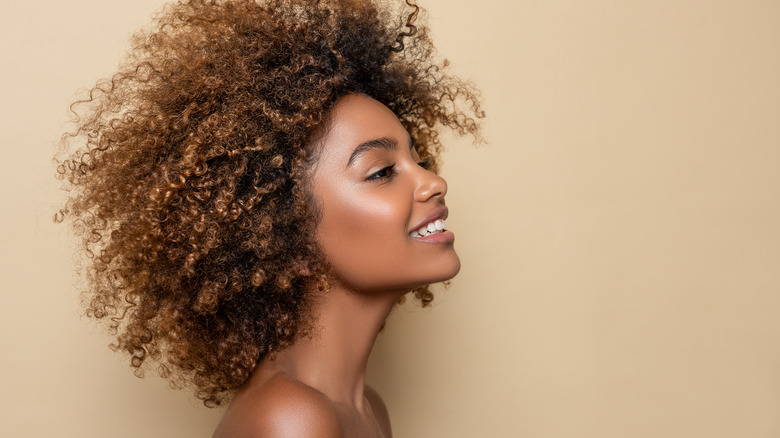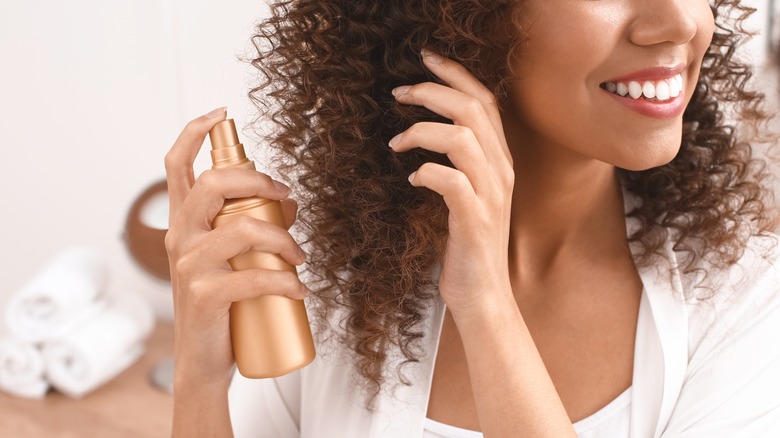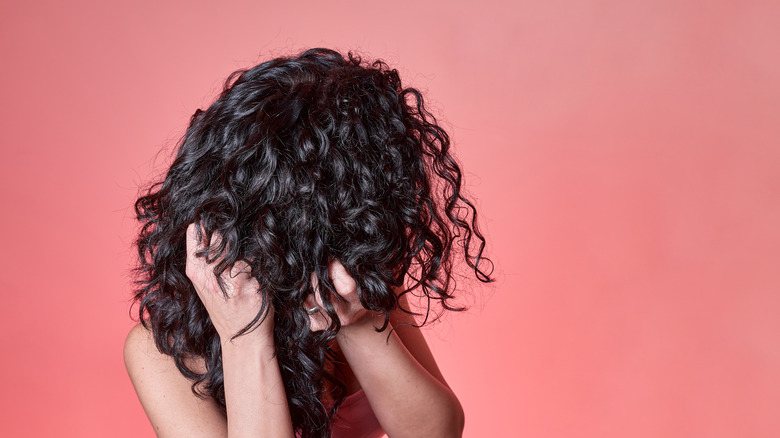The Ultimate Guide For Curly 3C Hair
We may receive a commission on purchases made from links.
Typifying your curly hair is an underestimated challenge; the spectrum of curls is infinite and finding your way through the swirls and knots can be overwhelming. Luckily, celebrity stylist Andre Walker started the conversation, revealing a wide range of curls and textures that need to be factored in while styling. This system was further developed to include nuances in curls: Straight hair is classified as Type 1, looser waves are Type 2, Type 3 includes tighter curly hair, and Type 4 curls are coily (via Madame Noire).
This article takes us further into the Type 3 community; Type 3C curls are the tightest of its counterparts, type 3A curls and 3B. According to Naturally Curly, "Type 3C curls resemble tight corkscrews and are approximately the circumference of a pencil or straw." Figuring out if you have Type 3C hair can be as simple as wrapping your curls around a pencil, but the online publication also has resources that lets you factor in your texture, length, and density. You could also reference the popular curly girl method, a method of cleansing and styling curly hair without sulfates and prioritizing moisture retention, to confirm if you have 3C curls. The method, detailed by Lorraine Massey, proposes replacing shampoo with conditioner washes for some days (via Cosmopolitan). "Your co-wash reveals your curl pattern, while your styling product captures [it]," Anthony Dickey of Hair Rules salon told Allure. Once you're sure you have 3B/3C curls, find our round up of products, routines, and advice.
Tackle specific concerns for 3C hair
Anyone with curly hair finds themselves in a battle against frizz, shrinkage, and dryness. Curly hair, in general, is more prone to these concerns since natural oils produced by your scalp can find it hard to travel down curly strands which leaves it hungry for moisture (via Healthline). "A strand of hair receives sebum on its exterior from the secretion of the sebaceous gland...Sebum is not evenly distributed along curls, resulting in drier hair," New York City-based board-certified dermatologist Francesca Fusco told Allure.
For type 3C curls, curl specialist Chloe Elliott told Stylist UK, "These curls are often characterized by their definition but can be susceptible to tangling. Working in four or more sections when washing and styling this curl type can help to minimize breakage from manipulation when detangling. It also makes the process easier if you have particularly dense hair." However, she continues, "What works for one set of curls may not work for the next, even if they look the same — the curl typing system doesn't take into account the unique characteristics of your curls that can help you better care for them."
Below, we've factored in your porosity, dryness, and shrinkage to create detailed routines that cater to specific concerns for 3C curls. The routines give you product recommendations and reviews based on the curly girl method — so, you'll find sulfate-free shampoos, conditioners, and styling gels. Of course, you can mix and match recommendations based on your hair.
Build a routine for your 3C curls
As a rule for anyone with curly hair, following the curly girl method is the easiest way to ensure healthy, happy curls. Lorrainne Massey, the author of "Curly Girl: The Handbook," explained the method to Newsweek as "a lifestyle and a way of living with a simple three-step curly hair routine, which entails no brushes or combs, using three to four products (max) that must be plant-based, botanically infused, fully water soluble and rich in natural emollients that deliver true hydration when coupled with water."
The steps to follow in this method are simple: cleanse, condition, and hydrate while styling. According to Naturally Curly, people with 3C curls can cleanse their hair once a week while co-washing with conditioner (while skipping shampoo) in 10-day intervals. Since 3C curls can sometimes feel similar to 4A curls, you could also reduce the frequency of your cleansing rituals. Your conditioner and leave-in products may depend on the texture and porosity of your hair but ideally, they should be hydrating and lightweight to allow definition to your curls.
3C curly hair hydrating routine
Curly hair has a habit of guzzling down conditioners, masks, and serums, somehow still remaining unquenched. The texture of curly hair, especially hair typified between 3A and 4C, grows out in a way that makes it harder for natural oils from the scalp to travel down. This means that every product in your routine needs to reinforce moisture in your 3C curls, without weighing them down.
With the curly girl method, you'd need to pick a curly hair shampoo that has no sulfates, alcohol, and if possible, no fragrance. These are all drying ingredients that can strip your hair of moisture, and this Kristin Ess curl shampoo ($12.49) from Amazon is a great option. For the days that you decide to co-wash (use a conditioner and skip the shampoo), Shea Moisture's Curl and Shine conditioner ($7.59), made with ingredients like shea butter, coconut oil, and silk protein, is one that comes recommended by more than 17,000 customers on Amazon. To ensure curl definition while eliminating frizz, your last moisture barrier comes in the form of Mielle's Mongongo Pomade to Oil Treatment ($8.25), a leave-in that soothes and hydrates your scalp while fighting humidity.
3C curly hair routine based on porosity
While stocking up on hydrating products for your hair is typically good advice, you need to pay attention to the kind of products you pick since your hair may or may not retain it based on its porosity. Basically, your hair porosity determines how much moisture it absorbs, and you can find out how porous your hair is based on a simple test: comb your hair and find a strand that's shedding, and drop it in a glass of water. "Hair that is low porosity will float. Hair that is 'normal' porosity will float and then begin to sink slowly. Hair that is high porosity will sink immediately," Atlanta-based salon owner Robin Groover told Byrdie.
If your curls have high porosity, chances are you have excessive frizz and dryness that cannot seem to hold onto product. This kind of hair is more prone to damage, and a protein treatment like Giovanni's Hair Reconstructor ($22.66 for 3) can help revitalize your cuticles and 3C curls without weighing them down. For low porosity hair, you need to focus on moisturizing your scalp as much as your strands, and a nourishing cleanser like Briogeo's Superfoods shampoo ($29) allows your cuticles to absorb the conditioner you're going to use later. Washing your low porosity hair more often is also a good idea, per Allure. Bonus tip: massage oil into your scalp before shampooing and use a deep conditioner after.
How to style 3C curly hair
Once you've got your wash day routine down, you need to pay attention to the way you style your 3C curls. You want your corkscrew curls to maintain definition, minimize shrinkage, stay moisturized, and be protected from frizzy offshoots. According to curl specialist Chloe Elliott,"This curl type likes curling creams and custards to style and can maintain definition with lightweight gels. As the curls are so tightly packed, it's worth bearing in mind that your hair will feel shorter when it's dry versus when it's wet as a result of shrinkage. Some will love it, others won't necessarily be a fan of it, but ultimately, shrinkage is a sign of healthy hair," (via Stylist UK).
Introduce your curls to some leave-in conditioner before you begin styling it, just to make sure you're combating dryness right from the start. Pick curl custards like the ever popular Kinky Curly Curling Custard ($29.99) and define your curls with products like Devacurl's Light Defining Gel ($26). "You can also take into account how thick or fine your strands are to decide whether to use lightweight or heavier products. Or you can consider how many strands you have on your head to determine how much product to use," Elliott continued, per Stylist UK. Allow your curls to air dry as much as possible since you want to avoid anything that can strip your hair of moisture, or use a diffuser with your hair dryer to speed up the process.





